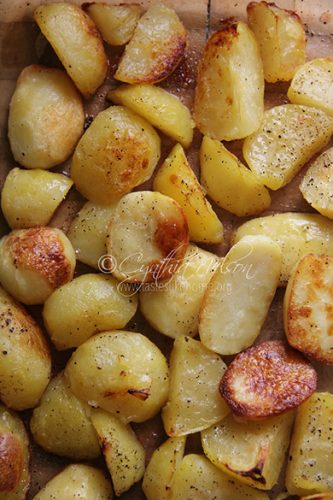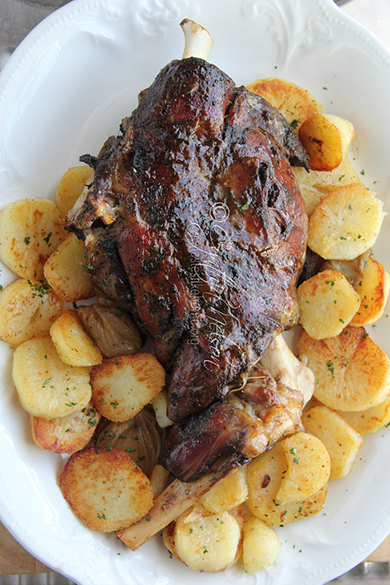 What’s Cooking is a series in which I answer questions and share advice about food and cooking that you have but may be too shy to ask.
What’s Cooking is a series in which I answer questions and share advice about food and cooking that you have but may be too shy to ask.
Hard as it is for some of us to believe, Christmas is just a little over 4 weeks away. I was reminded of it this week as emails came in requesting ideas and how-to for the big holiday meal. A repeated question was how to roast potatoes, so here goes.
Roast potatoes are a popular side dish for Sunday lunch and holiday meals, and they quickly disappear from a platter. Crisp on the outside, soft and fluffy on the inside, these large chunks of golden spuds are comfort food at its best. If they are flavoured with spices or herbs, oh man, you can be in danger of taking more than your fair share. When making roasted potatoes, make nuff!

How does one make a pan of perfect roast potatoes? Well, we first need to recognize that perfection is relative, and it depends on what you look for in roast potatoes and understand that that is influenced by what we grew up eating.
There is more than one approach to roasting potatoes. There is enough time for us to do some testing, therefore, I recommend trying them all over a period of time to determine which one works best for you. Each method will yield a different texture. Let’s get to it.
Potatoes
All varieties of potatoes we get here in the Caribbean can be roasted. The main thing is to get the freshest potatoes you can. Buy firm, blemish-free potatoes.
To peel or not to peel – that is entirely up to you. If you are planning not to peel the potatoes, they need to be scrubbed well to remove any dirt. If the potatoes are small then there is no need to cut them, however, if the spuds are large, then half and quarter them as necessary. You do not want tiny pieces of potatoes; remember they are often the side to a main dish, so they have to be substantial.
Roasting
A simple and straightforward approach is to clean the potatoes, cut them, season with salt and pepper (spices and herbs if using), along with some type of cooking fat and cook in a hot oven, tossing a couple of times during the process. This approach takes longer for the potatoes to cook and yield firm cooked potatoes. There is no particular texture to the crust.
Another method – and this is the method I use – is to par-cook the potatoes in boiling salted water, drain well, toss with spices or herbs if using, along with oil or some other type of fat and roast in a hot oven. This method yields a thin crisp crust and tender inside.
The other way to roast potatoes is to bring them to boil in salted water, drain well, toss the potatoes around in a covered pot or shake them around in the colander to rough up the outsides and then add to a heated pan with some type of fat and roast in a hot oven. Alternately, you can run the tines of a fork over the boiled potatoes to create a texture on the outside. This method results in a very crispy outside and fluffy inside. Adding the fluffed-up potatoes to a hot pan means that the outside gets sealed and crisp almost immediately.
Seasoning and fat
Potato, like pasta, is one of those ingredients that needs to be seasoned in the preliminary cooking stage, in this case, when it is being boiled. This approach ensures the potatoes are seasoned (with salt) from the inside and not just on the outside. Fresh herbs and spices are added while being tossed with a cooking fat before going into the oven.
Most of the times, freshly ground black pepper is all you need but do not be shy about trying different types of seasonings, for example, whole or ground cumin (geera). Ground allspice, coriander, Sichuan peppercorns, garlic powder and chili powder are all good additions. On the herbal side, finely minced thyme, rosemary, tarragon, sage, marjoram and oregano would make flavourful roast potatoes. Ideally, use the fresh rather than the dried version of these herbs if not they can overpower given the type of cooking technique involved and duration of cooking.
The type of cooking fat used adds flavour to the potatoes as well. Rendered bacon fat, duck fat, beef fat as well as the drippings from your Sunday roast – pork, beef, chicken or lamb – all elevate humble roast potatoes to something extra special. Keep that in mind for the upcoming holiday season. Oh, the ham drippings are excellent too for tossing the potatoes and roasting. Of course, regular vegetable oil works just fine.
Pan
A sheet tray pan makes for easy roasting of the potatoes because you want enough room to spread the potatoes out in an even layer. It also makes it easy for tossing the potatoes to ensure that they get crusty on both sides. A large cast iron skillet does the job too but do not over crowd the pan. The idea about roasting the potatoes to develop a crust is to ensure that the potatoes are making direct contact with the pan.
I recommend roasting in a preheated 400 degrees F oven and tossing/turning the potatoes halfway through the cooking process. The timing will vary depending on the variety and size of potatoes. The potatoes are done when a knife inserts easily.
Cynthia
Cynthia@tasteslikehome.org





